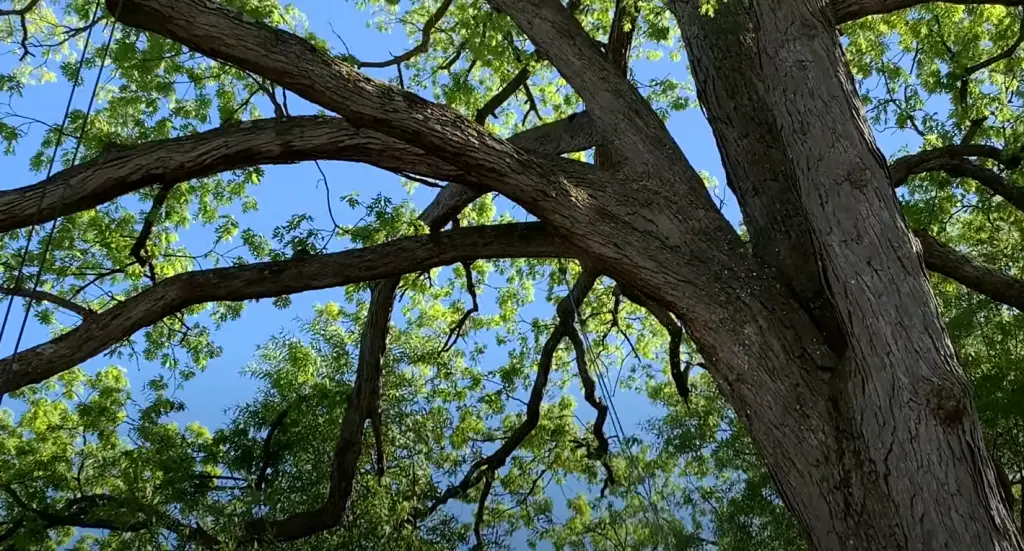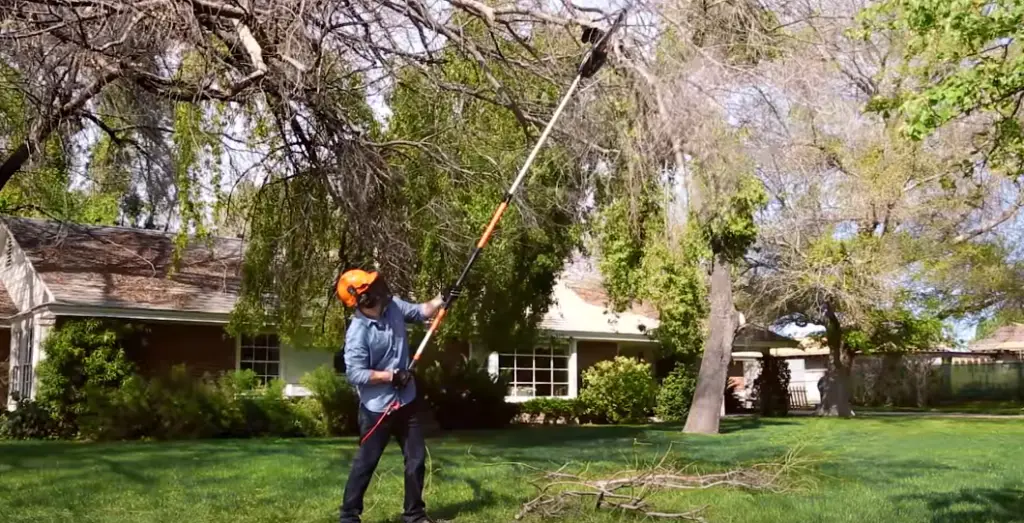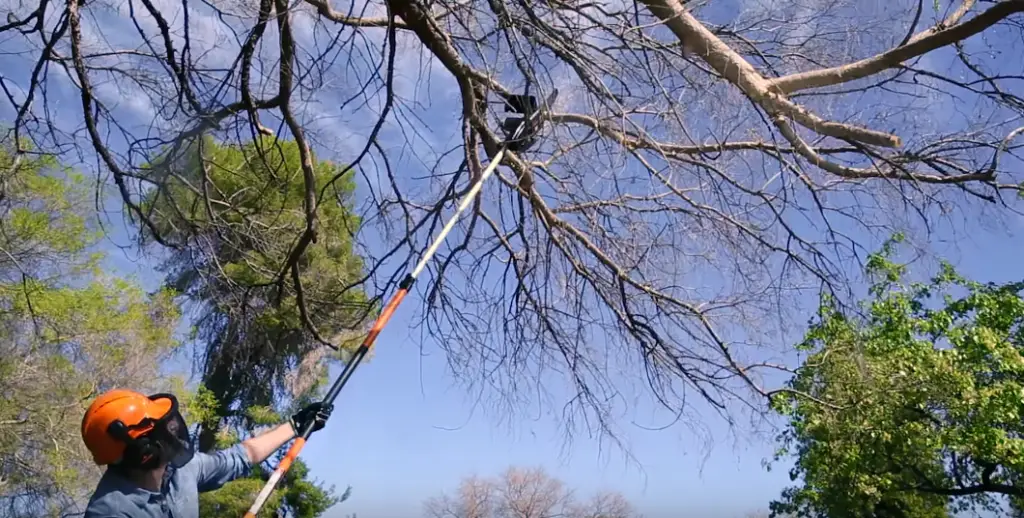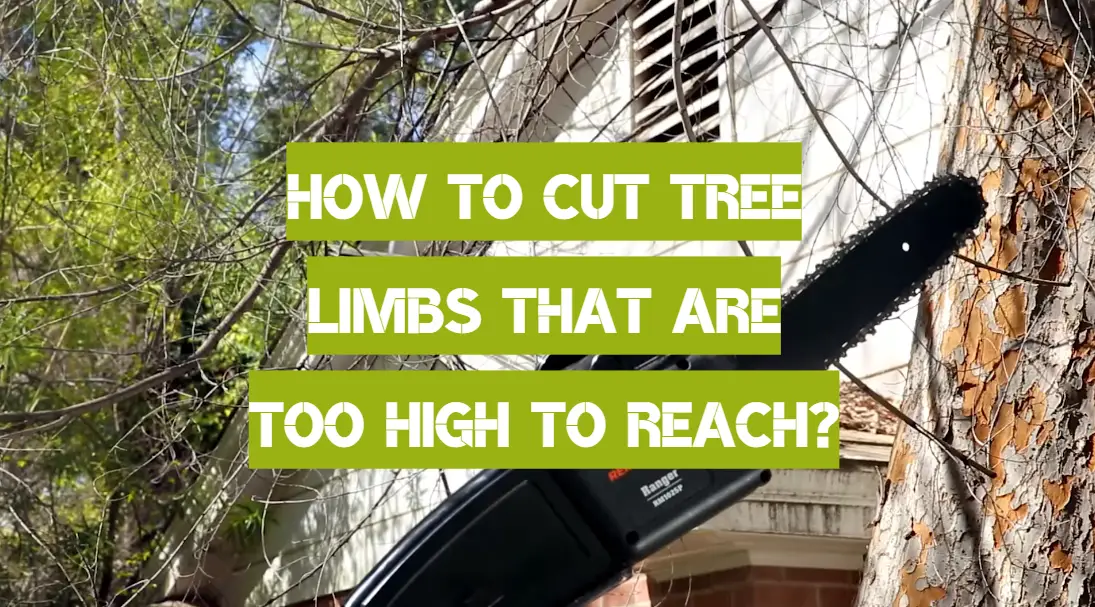Table of Contents
Trimming high tree branches of very tall trees with a pole saw
Pole saws are very popular instruments among gardeners who need to cut the bushes and trees. This very convenient gardening tool may work manually or almost automatically. Make sure to buy a pole saw according to your tasks. If you are going to trim the trees occasionally, buy the cheapest pole saw that resembles a small saw on a long telescopic handle. If you need to cut the tall and thick trees, it makes sense to invest in more expensive and powerful – electric or gas instruments. Check their differences.

Different types of pole saws:
1) Manual or mechanic pole saws look like modified garden shears with long handles. They are lightweight, relatively small, affordable and easy to apply. Among their cons are low effectiveness and a lot of muscle effort. So it won’t do for cutting too thick branches and I won’t recommend them if you have problems with muscle strength.
2) Electric pole saws are devices equipped with an electric motor. There are cord-based and cordless instruments. The main advantages of electric pole saws are: low price, high power, easy maintenance, the cutting headset resembles a chainsaw, low noise, and low weight. I do not recommend buying cord-based electric tools because they limit the movements and won’t do for tall trees specifically.
3) Gasoline pole saw is a garden tool driven by an internal combustion engine. It has exceptional performance. The main advantages are a professional headset, the ability to work in all weather conditions. The cons are high prices, high noise levels, and weight. However, they are perfect when you need to cut thick and tall branches at the very top of high trees.

Considering the above-mentioned facts, that is what you must check before buying a pole saw:
- The ratio of price and quality. Pruning high trees with thick branches needs a lot of power from a pole saw. But think – how many times are you going to use pole saw tools during a year?
- Performance and availability of professional headset resembling a chainsaw;
- Weight and required muscle strength;
- Noise level;
- Device mobility;
- Availability of additional features;
Step-by-step guide for cutting high trees limbs and trunk:
- Trim the trunk properly with a pole saw. The best height for any tree is 6.5 ft. It is important to correctly cut the trunk – just above the upper branch near the trunk, literally 3-5 inches. If you leave a stump, it will soon decay, and a hollow will form on the crown where rainwater will fall. And then the tree will die quickly;
- Cut all shoots growing inside the crown. They thicken the tree, air, and moisture stagnate inside, and pests may settle and, as a result, fungi multiply. Cut the tree until it resembles the shape of a bowl: empty inside, all the branches are located outside. Gardeners say: “A sparrow should fly through the tree’s crown”;
- Trim the lateral branches. Their length should be approximately 8 ft. And you need to cut them to an external branch that “pops” out;
How to cut high tree branches: possible problems you come across
The first advice – the best time to cut the old and thick branches of tall trees is in early spring. Here is how you should cut tree limbs that are too high to reach:
- Top branches. Some new shoots often grow inside the crown or directly on the trunk – in such a way, the tree is trying to restore the previous volume of the crown. But they need to be cut. Better yet, pluck as soon as they appear – in such a way, the trees will be less injured.
- Broken branches. The size of the crown and the volume of the roots of any tree are balanced. After the major pruning, this balance is violated – a huge number of roots actively pump water and supply nutrients to the top, leaving fewer shoots and leaves. But sometimes the branches grow to be too thick and break. And if the trees are very large and thick, then prune more than once a year.
- Check the wounded branches. After major pruning, the tree is literally covered with cut wounds. And any wound is an open gate for infection. AS soon as the tree is rejuvenated, immediately smear all the damage, including small sections of old thin twigs – use the shears.

Trimming high tree branches on the very top
- Reduce the crown after the fall of leaves in autumn or before blooming in spring;
- First, all dry, broken and diseased branches must be instantly removed. Then they cut branches intertwined with each other. Then cut the tree limbs that are too high to reach – usually they grow inside the crown. And only after that cut the crown itself;
- Pruning should be done with a clean and sharp instrument;
- Side branches must be cut into a ring;
- You should not leave hemp during trimming – many top branches will immediately appear on them. It is necessary to cut branches. Then the tops will not grow so actively, and all the nutrition will go to the development of the crop;
How to trim high branches on fruit trees?
Pruning of tall and thick fruit trees should be done from the top if you need to cut the crown. Old apple trees and pears grow up to 20 – 25 feet, and cherry trees up to 30 ft. You can reduce the trees by 10-12 ft. First, cut over any branches that go to the side. After this, it is necessary to study the lower branches, determine their height from the ground. If they grow too low, the lowest limbs of a high tree should be cut. Next, remove the branches that grow inside the crown and twisted branches.
If you want to reduce the growth of a tree (for example, pears or apple trees) when it comes to the crown, then cut long branches and leave the short ones. These two species of fruit trees do not need their limbs to be cut. As for cherries, apricots, peaches, and walnuts, their twigs can be trimmed once or twice a year. They very quickly grow new branches that bear fruit abundantly next year.
Trimming high tree branches: common tips
- A thick and tall tree has to be pruned annually – usually about half of all branches must be cut;
- When pruning old or sick trees, you may find the branches affected by bacteria. Cut them off completely;
- If the pruning was strong, then there will be many wounds on the tree, so you should treat them with a special garden putty. Be careful when cutting tree limbs that are too high to reach;
Comparison of Methods to Cut Tree Limbs That Are Too High to Reach
Cutting tree limbs that are too high to reach can be a challenging task. There are several methods available to do this, each with its own advantages and disadvantages. In this table, we compare various indicators for the most popular methods of cutting tree limbs that are too high to reach.
| Method | Cost | Effort Required | Safety | Precision | Environmental Impact |
|---|---|---|---|---|---|
| Use of Pole Pruner | Low | Low | High | Low | Low |
| Use of Ladder | Low-Medium | Medium | Medium | Medium | Low-Medium |
| Use of Aerial Lift | High | High | High | High | High |
| Use of Climbing Gear | Medium-High | High | Medium | High | Low |
The table compares the most common methods used to cut tree limbs that are too high to reach. The indicators compared are cost, effort required, safety, precision, and environmental impact.
The use of a pole pruner is a low-cost and low-effort method, but it requires more safety precautions, and the precision is lower. The environmental impact is low as it does not require any machinery.
The use of a ladder is a low to medium-cost method that requires medium effort, but it has a moderate level of safety, and the precision is moderate as well. The environmental impact is low to medium as it requires transportation of the ladder.
The use of an aerial lift is the most expensive method and requires the most effort, but it provides the highest level of safety and precision. The environmental impact is also high as it requires the use of machinery.
The use of climbing gear is a medium to high-cost method that requires a high level of effort, but it has a moderate level of safety and a high level of precision. The environmental impact is low as it does not require any machinery.
FAQ
How do you trim hard to reach branches?
Trimming hard to reach branches can be a difficult task, but with the right tools and safety precautions, it’s possible.
The first step is to choose the appropriate tool for the job. A pole saw or pruner is ideal for high branches, as they allow you to cut from a safe distance. For lower branches, a hand saw or pruning shears may be more suitable.
When using any of these tools, it’s important to take safety precautions such as wearing protective eyewear and gloves. Additionally, it can be helpful to have someone else hold the ladder steady if you’re using one. Finally, make sure you are properly informed about proper tree trimming techniques before attempting any task.
What saw to use to cut high tree branches?
The best saw to use to cut high tree branches is a pole saw. A pole saw is a small chainsaw at the end of an extendable pole, usually between 6 and 10 feet long. This allows you to reach high branches without having to climb up into the tree. Pole saws are lightweight and easy to operate, making them a great choice for cutting high tree branches. They also typically have small blades which make precise cuts in thin or small branches. Make sure that you read the safety instructions before using a pole saw, and wear eye protection as well as gloves when operating it.
How do you cut vertical tree limbs?
Cutting vertical tree limbs can be a tricky task, but it is possible with the right tools and technique.
First, you will need to gather the proper tools for the job. A chainsaw is the most effective tool for cutting through thick tree limbs, but a handsaw or pruning saw can also work if the limb is thinner. Make sure to wear safety glasses and gloves when using any type of sawing tool.
Next, you’ll need to properly position yourself for the cut. Stand on a sturdy ladder or platform that gives you a good view of the limb and plenty of room to maneuver your arms. Make sure your footing is secure before starting any cuts. Once in position, use your saw to make several shallow cuts around the circumference of the limb until it breaks off cleanly from the trunk. Be sure not to cut too deep into the tree’s bark as this can damage its health.
How do you cut high tree branches with a chainsaw?
Cutting high tree branches with a chainsaw is a dangerous task and should only be done by experienced individuals. Before attempting this job, make sure you have the proper safety equipment, such as eye protection, heavy-duty gloves, and hearing protection.
To begin cutting high tree branches with a chainsaw, use an extension ladder to reach the branch. Make sure that the ladder is stable and secure before climbing up it. When you reach the branch, make sure to hold onto the ladder with one hand while operating the chainsaw with your other hand. Start by making a cut on the underside of the branch at a slight angle away from your body. This will help prevent kickback from occurring when you finish cutting through the branch. Once you have made your initial cut, finish cutting through the branch by making a second cut on top of it at an angle towards your body. When finished, slowly lower yourself down from the ladder and remove any debris or sawdust created during your work.
Can you use an angle grinder to cut tree branches?
Yes, you can use an angle grinder to cut tree branches. An angle grinder is a versatile tool that can be used for a variety of tasks such as grinding, cutting, and polishing. When using an angle grinder to cut tree branches, it is important to ensure that the blade is sharp and in good condition. This will help ensure a clean and precise cut. Additionally, you should wear protective gear such as safety glasses and gloves to protect yourself from flying debris. It is also important to be aware of your surroundings and any potential hazards when using an angle grinder near trees or other objects. With these precautions in place, you can safely use an angle grinder to cut tree branches.
Which is not a best practice tree trimming technique?
Topping is not a best practice tree trimming technique. Topping is when the main leader of a tree is cut back to stubs, leaving lateral branches to take over as the new leader. This practice causes rapid growth of multiple leaders, weakens the structure of the tree, and can lead to disease and insect infestation. It also eliminates much of the natural beauty that comes from having one strong leader.
Instead, trees should be pruned selectively in order to maintain their shape and remove dead or diseased branches. This selective pruning should focus on maintaining healthy branches and removing those that are at risk for failure or disease. Proper pruning techniques also allow for more light penetration into the canopy which can help reduce competition with other plants or structures.
Finally, it’s important to remember that trees are living organisms and they need time to heal after any type of trimming or pruning.
Final thoughts
As you can see, it is easy to cut tree limbs and branches that are too high to reach. Just use pole saws or shears with long handles. But be careful – if you are not sure in your strength, make sure to hire professional gardeners.







Leave a Reply